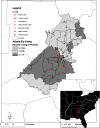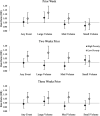Combined Sewer Overflows and Gastrointestinal Illness in Atlanta, 2002-2013: Evaluating the Impact of Infrastructure Improvements
- PMID: 35580035
- PMCID: PMC9113542
- DOI: 10.1289/EHP10399
Combined Sewer Overflows and Gastrointestinal Illness in Atlanta, 2002-2013: Evaluating the Impact of Infrastructure Improvements
Abstract
Background: Combined sewer overflows (CSOs) discharge untreated sewage into surface and recreational water, often following heavy precipitation. Given projected increases in frequency and intensity of precipitation due to climate change, it is important to understand the health impacts of CSOs and mediating effects of sewerage systems.
Objectives: In this study we estimate associations of CSO events and emergency department (ED) visits for gastrointestinal (GI) illness among City of Atlanta, Georgia, residents and explore how these associations vary with sewerage improvements.
Methods: We estimate associations using Poisson generalized linear models, controlling for time trends. We categorized CSOs by overflow volume and assessed effects of CSO events prior to ED visits with 1-, 2- and 3-wk lags. Similarly, we evaluated effects of weekly cumulative precipitation greater than the 90th percentile at the same lags. We also evaluated effect modification by ZIP Code Tabulation Area (ZCTA)-level poverty and infrastructure improvement period using interaction terms.
Results: Occurrence of a large volume CSO in the previous week was associated with a 9% increase in daily ED visits for GI illness. We identified significant interaction by ZCTA-level poverty, with stronger CSO-GI illness associations in low than high poverty areas. Among areas with low poverty, we observed associations at 1-wk and longer lags, following both large and lower volume CSO events. We did not observe significant interaction by infrastructure improvement period for CSO- nor precipitation-GI illness associations; however, the number of CSO events decreased from 2.31 per week before improvements to 0.49 after improvements.
Discussion: Our findings suggest that CSOs contribute to acute GI illness burden in Atlanta and that the magnitude of this risk may be higher among populations living in areas of low poverty. We did not find a protective effect of sewerage system improvements. Nonetheless, observed reductions in CSO frequency may lower the absolute burden of GI illness attributable to these events. https://doi.org/10.1289/EHP10399.
Figures






Similar articles
-
Association between Combined Sewer Overflow Events and Gastrointestinal Illness in Massachusetts Municipalities with and without River-Sourced Drinking Water, 2014-2019.Environ Health Perspect. 2024 May;132(5):57008. doi: 10.1289/EHP14213. Epub 2024 May 22. Environ Health Perspect. 2024. PMID: 38775485 Free PMC article.
-
Extreme Precipitation and Emergency Room Visits for Gastrointestinal Illness in Areas with and without Combined Sewer Systems: An Analysis of Massachusetts Data, 2003-2007.Environ Health Perspect. 2015 Sep;123(9):873-9. doi: 10.1289/ehp.1408971. Epub 2015 Apr 9. Environ Health Perspect. 2015. PMID: 25855939 Free PMC article.
-
Combined sewer overflow events and childhood emergency department visits: A case-crossover study.Sci Total Environ. 2017 Dec 31;607-608:1180-1187. doi: 10.1016/j.scitotenv.2017.07.104. Epub 2017 Jul 17. Sci Total Environ. 2017. PMID: 28732397 Free PMC article.
-
Current and future approaches to wet weather flow management: A review.Water Environ Res. 2021 Aug;93(8):1179-1193. doi: 10.1002/wer.1506. Epub 2021 Jan 23. Water Environ Res. 2021. PMID: 33393150 Review.
-
Addressing the challenges of combined sewer overflows.Environ Pollut. 2024 Feb 15;343:123225. doi: 10.1016/j.envpol.2023.123225. Epub 2023 Dec 25. Environ Pollut. 2024. PMID: 38151091 Review.
Cited by
-
Association between Combined Sewer Overflow Events and Gastrointestinal Illness in Massachusetts Municipalities with and without River-Sourced Drinking Water, 2014-2019.Environ Health Perspect. 2024 May;132(5):57008. doi: 10.1289/EHP14213. Epub 2024 May 22. Environ Health Perspect. 2024. PMID: 38775485 Free PMC article.
-
A social-ecological-technological vulnerability approach for assessing urban hydrological risks.Ecol Indic. 2025 Apr;173:113334. doi: 10.1016/j.ecolind.2025.113334. Ecol Indic. 2025. PMID: 40255455 Free PMC article.
-
Differential Effectiveness of Water, Sanitation, and Handwashing Interventions to Reduce Child Diarrhea in Dry and Rainy Seasons: A Systematic Review and Meta-Analysis of Intervention Trials.Environ Health Perspect. 2025 Feb;133(2):26001. doi: 10.1289/EHP14502. Epub 2025 Feb 4. Environ Health Perspect. 2025. PMID: 39903556 Free PMC article.
-
Quantifying the land and population risk of sewage spills overland using a fine-scale, DEM-based GIS model.PeerJ. 2023 Nov 20;11:e16429. doi: 10.7717/peerj.16429. eCollection 2023. PeerJ. 2023. PMID: 38025695 Free PMC article.
-
How Improved Is Improved Enough? Gastrointestinal Illness Risk after Sewer Infrastructure Upgrades.Environ Health Perspect. 2022 Jun;130(6):64002. doi: 10.1289/EHP11525. Epub 2022 Jun 14. Environ Health Perspect. 2022. PMID: 35700065 Free PMC article.
References
-
- Lall U, Johnson T, Colohan P, Aghakouchak A, Brown C, McCabe G, et al. 2018. Chapter 3: Water. In: Impacts, Risks, and Adaptation in the United States: Fourth National Climate Assessment, vol 2. Reidmiller DR, Avery CW, Easterling DR, Kunkel KE, Lewis KLM, Maycock TK, eds. https://nca2018.globalchange.gov https://nca2018.globalchange.gov/chapter/3 [accessed 26 March 2021].
-
- Prein AF, Rasmussen RM, Ikeda K, Liu C, Clark MP, Holland GJ. 2017. The future intensification of hourly precipitation extremes. Nat Clim Chang 7(1):48–52, 10.1038/nclimate3168. - DOI
-
- Smith KR, Woodword A, Campbell-Lendrum D, et al. . 2014. Human health: Impacts, adaptation, and co-benefits. In: Climate Change 2014: Impacts, Adaptation, and Vulnerability. Part A: Global and Sectoral Aspects. Contribution of Working Group II to the Fifth Assessment Report of the Intergovernmental Panel on Climate Change. Cambridge, UK: Cambridge University Press, 709–754.
-
- Jagai JS, Li Q, Wang S, Messier KP, Wade TJ, Hilborn ED. 2015. Extreme precipitation and emergency room visits for gastrointestinal illness in areas with and without combined sewer systems: an analysis of Massachusetts data, 2003–2007. Environ Health Perspect 123(9):873–879, PMID: , 10.1289/ehp.1408971. - DOI - PMC - PubMed
MeSH terms
Substances
Grants and funding
LinkOut - more resources
Full Text Sources

